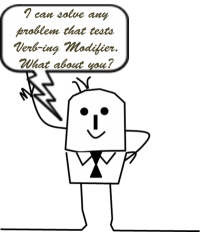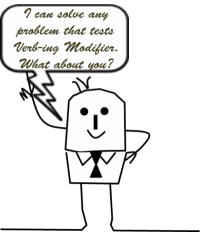
Introduction:
Verb-ing modifiers are one of the most heavily tested concepts in GMAT, and needless to say, one of the most dreaded concepts as well. The usage of this modifier often creates confusion because the function of a verb-ing modifier changes with the change in its placement in a sentence. This article is aimed at simplifying the usage of this “dreaded” modifier and helping you understand the functionality of this modifier better.
But before that, we have a small warm-up exercise. Attempt this short quiz and see how well you understand this concept currently.
Quiz it
- Students have been throwing away healthy meals made available in school cafeteria by The Los Angeles Unified School District and bringing their own junk food to school and these forced the district to bring back some of the foods it worked so hard to replace.
- school and these forced
- schools, which forced
- schools, forcing
- In three months, biologist Glauco Machado gathered enough information about large numbers of a relatively unstudied order of arachnids to persuade an ant specialist at the university to advise him and to publish his first scientific paper.
- arachnids to persuade an ant specialist at the university to advise him and to publish
- arachnids, persuading an ant specialist at the university to advise him and publishing
- arachnids persuading an ant specialist at the university to advise him and publishing
Check your Answers
- 1 – 3. Correct
- 2 – 1. Correct
(Detailed solutions in sections RULE SET #1 and RULE SET #2, respectively)
Outline
Understanding Verb-ing Modifiers
As the name suggests, verb-ing modifiers are words that are constituted from “verbs” by adding “ing” to them. Essentially, these modifiers modify a particular entity in the sentence. The modification depends upon the placement of the modifier in the sentence, i.e., where and how they appear in the sentence. Since these modifiers are made from verbs, they denote action.
For example:
Mary cooked delicious food using fresh condiments.
The verb-ing modifier “using fresh condiments” denotes an action in this sentence. It communicates the meaning – Mary used fresh condiments.
Placement of Verb-ing Modifiers
The function played by a verb-ing modifier depends upon where and how it appears in the sentence. The verb-ing modifiers can take three places in a sentence:
- Placed after a clause and PRECEDED by a comma,
- Placed after a noun and NOT PRECEDED by a comma,
- Placed at the beginning of a clause followed by a comma.
Needless to say, the function of the verb-ing modifier changes with the change in its placement regarding the three structures mentioned above. Let’s discuss the first structure that brings us to our first rule set for this modifier.
Modifiers are one the most commonly tested topics on the GMAT SC. Read our article on What is tested on the GMAT SC to know more about other commonly tested errors on the GMAT SC.
We cover all the concepts required to ace the GMAT SC, starting from the foundations of GMAT grammar in the e-GMAT SC course. We also have 400+ GMAT level practice questions with detailed solutions. Begin your GMAT preparation with our free trial today!
Functions: Rule set #1
If the verb-ing modifier appears after a clause and is preceded by a comma, then it modifies the entire preceding clause. It either presents generic information about the preceding clause, or presents the result of the preceding clause.
The verb-ing modifier can be placed after a clause and separated from the preceding clause by a comma.
Presenting Generic Information
SIMPLE EXAMPLES: Presenting Generic Information
Mary made a beautiful bouquet, arranging rare exotic flowers in certain symmetry.
This sentence means that Mary made a beautiful bouquet. And how did she do it? This question is answered by the verb-ing modifier “arranging rare exotic flowers in certain symmetry”. i.e. Mary made a beautiful bouquet BY ARRANGING rare exotic flowers in certain symmetry.
In this sentence, verb-ing modifier is preceded by a comma. This means that this modifier modifies the preceding clause. In this sentence, the verb-ing modifier is presenting generic information about the preceding clause.
GMAT-like SENTENCE: Presenting Generic Information
For decades now, Illinois Natural History Survey biologists in aluminum skiffs have scooted up and down the thinly wooded banks of the Illinois river and monitored local fish, catching, recording, and releasing approximately 150,000 of them a year.
This sentence means that for a very long time now, the INHS biologists have gone to the banks of the Illinois river in aluminum skiffs and have monitored local fish. And how they have monitored local fish? They have done so by catching, recording, and releasing some 150,000 fish a year.
In this sentence, all three verb-ing modifiers (parallel entities) appear in the sentence after the clause preceded by comma. Hence, they modify the entire preceding clause. Per the context of this sentence, we know that the three verb-ing modifiers are presenting generic information about the preceding clause. The three modifiers explain how the biologist did the job of monitoring local fish. They monitored local fish by catching them, putting them in records, and releasing them back in the river.
Presenting result
SIMPLE EXAMPLES: Presenting the result
Now let’s look at this one:
- Mary made a beautiful bouquet, winning accolades from every one.
This sentence tells us that Mary made a beautiful bouquet. It further explains that this action resulted in Mary winning a lot of accolades from every one.
In this sentence, the verb-ing modifier appears after the clause preceded by a comma. This means the modifier will modify the entire preceding clause. In this sentence “winning accolades from every one” is presenting the result of the preceding clause.
GMAT like SENTENCE: Presenting the result
Let us bring our “warm-up exercise” question #1 here. Let us solve that GMAT like question to see why the correct answer is correct and how this rule set is applicable in that question.
Q#1 – Why the correct answer is correct
- Students have been throwing away healthy meals made available in school cafeteria by The Los Angeles Unified School District and bringing their own junk food to school and these forced the district to bring back some of the foods it worked so hard to replace.
We will apply the e-GMAT three-step process to solve this problem.
STEP 1: MEANING ANALYSIS
This sentence says that Los Angeles Unified School District added healthy meals to the school cafeteria. But students have been throwing away these healthy meals and have been bringing their own junk food. As a result of these actions, the district was forced to bring back some of the foods it worked so hard to replace.
STEP 2: ERROR ANALYSIS
Let’s now split the sentence into clauses to spot the errors:
- Students have been throwing away healthy meals made available in school cafeteria by The Los Angeles Unified School District and bringing their own junk food to school
- and these forced the district to bring back some of the foods
- it worked so hard to replace.
In the second clause, pronoun “these” have been used to refer the actions of “throwing healthy meals” and “bringing junk food”. This usage is not correct because “these” is a pronoun. It can only refer to a noun or another pronoun. It cannot be used to refer to an action or a clause.
STEP 3: POE
- school and these forced: Incorrect for the reason discussed during error analysis.
- schools, which forced: Incorrect. Notice that “which” is a noun modifier that refers to the preceding noun or noun phrase. In this choice, “which” is referring to “schools”. This is illogical. Also notice that “which” is a relative pronoun that abides by the same rules for pronoun. Hence, “which” cannot be used to present the result of the preceding clause.
- Schools, forcing: Correct. The verb-ing modifier “forcing” appears in this sentence preceded by a comma. This means that “forcing” is modifying the preceding clause. Per the context of the sentence, comma + forcing, in this choice, is correctly presenting the result of the preceding clause.
Applying RULE SET #1 On Official Question
OG 12 #47
Five fledgling sea eagles left their nests in western Scotland this summer, bringing to 34 the number of wild birds successfully raised since transplants from Norway began in 1975.
- bringing
- and brings
- and it brings
- and it brought
- and brought
We will solve this question, using e-gmat three-step process.
STEP 1: MEANING ANALYSIS
The sentence says that this summer, five fledgling sea eagles left their nests in western Scotland. This action brought to 34 the total number of wild birds that have been successfully raised since transplants from Norway started in 1975.
STEP 2: ERROR ANALYSIS
Let us split the sentence into clauses to spot the errors.
- Five fledgling sea eagles left their nests in western Scotland this summer, bringing to 34 the number of wild birds successfully raised
- since transplants from Norway began in 1975.
The only word underlined in this sentence is the verb-ing modifier “bringing”. This modifier appears after the main clause preceded by a comma. This means it modifies the preceding clause. The use of this modifier is correct here because per the context, it presents the result of the preceding clause – one of the functions of the verb-ing when preceded by a comma. Hence, there is no error in this sentence. This sentence is correct as is.
STEP 3: POE
Through this step we will find out why the other answer choices are incorrect.
- bringing: Correct as explained during error analysis.
- and brings: Incorrect. “brings” is not the correct verb tense to refer to an action that took place in the past. Furthermore, use of ‘comma + and’ to connect two entities in a list – here two verbs of the same subject – is not correct.
- and it brings: Incorrect.
- Singular pronoun “it” neither can refer to plural “eagles” nor can refer to the preceding clause. A pronoun can only refer to a noun or another pronoun.
- Repeats the same verb tense error as in Choice B.
- and it brought: Incorrect. Repeats the same pronoun error as in Choice D.
- and brought: Incorrect. Use of ‘comma + and’ to connect two entities in a list – here two verbs of the same subject – is not correct.
A point to remember
As mentioned earlier, verb-ing modifiers are made from “verbs” and they denote action. Now, any action needs a doer. In the same way, the verb-ing modifiers also associate with the subjects of the preceding clause. What we must keep in mind is that the action denoted by verb-ing must make sense with the subject of the clause. The use of verb-ing is correct only if it makes sense with the subject of the clause it is modifying.
For example:
- Sachin Tendulkar played an exceptionally outstanding innings, making the team win gloriously.
The sentence means that Sachin played a superbly good innings. And the result of this action led to the victory of the team in a glorious manner. So, the verb-ing modifier “making” preceded by a comma is presenting the result of the preceding clause.
Now, “making” is an action that needs a subject. Per the rule, it will associate with the subject of the preceding clause. Now, the subject of the preceding clause “Sachin” did the action of playing a superb innings. So the subject is the doer. Hence, “making” will associate with the same subject and will suggest that that Sachin “made” the team win. This association perfectly makes sense. Because Sachin did make the team win by playing a superb innings. Hence, the usage of the verb-ing modifier is absolutely correct here.
Now let’s take this example:
- Joe became the CFO of the company, increasing his pay significantly.
Here the verb-ing modifier “increasing” appears after the clause and is preceded by a comma. This means that this modifier will modify the preceding clause either by presenting additional information about the preceding clause or by presenting the result of the preceding clause.
Now, per the intended meaning of the sentence, Joe became the CFO of the company. This event led to increase in his salary. Now, the subject of the sentence is “Joe”. However, he is not the doer of the verb “became”. He did not make himself the CFO of the company. Now look at the verb-ing modifier “increasing”. Since verb-ing modifier denotes an action and hence associates with a verb, “increasing” associates with “Joe”. The sentence thus means that Joe became the CFO of the company and as a result he increased his salary. We know that this is not even a possibility. What resulted in Joe’s increased salary is the event of his becoming the CFO.
Hence, even if this sentence appears to be written in appropriate construction, it is incorrect since here the verb-ing modifier does not make sense with the subject of the preceding clause. This sentence can be written correctly as follows:
- Joe became the CFO of the company, a move that increased his pay significantly.
Take Aways for RULE SET#1
- Since verb-ing modifiers are made from verbs, they denote action.
- When a verb-ing modifier appears after a clause preceded by a comma, then it modifies the entire preceding clause. It presents either additional information or result of the preceding clause.
- The verb-ing modifier must make sense with the subject of the preceding clause.
OG questions you can practice using these rule sets
Apply these rule sets to the following OG questions.
OG 12# 30, 65, 94
OG Verbal Review 2# 14, 78,
OG 13# 97
Modifiers are one the most commonly tested topics on the GMAT SC. Read our article on What is tested on the GMAT SC to know more about other commonly tested errors on the GMAT SC.
We cover all the concepts required to ace the GMAT SC, starting from the foundations of GMAT grammar in the e-GMAT SC course. We also have 400+ GMAT level practice questions with detailed solutions. Begin your GMAT preparation with our free trial today!
Functions: Rule Set #2
The placement of the verb-ing modifier after a clause without a comma brings us to the second rule set for this modifier.
Let’s understand the application of this rule set through simple examples first.
If the verb-ing modifier appears after a clause and without a comma, then it modifies the preceding noun or noun phrase.
SIMPLE EXAMPLE
Mary made a beautiful bouquet releasing divine aroma.
In this sentence “releasing…” is a verb-ing modifier that is not preceded by a comma. In this construction, “releasing…” modifies the preceding noun “bouquet”. The sentence means that Mary made a beautiful bouquet and that bouquet releases a divine aroma. So the modifier describes the noun – bouquet.
Understanding Intended meaning is the key: As you would have noticed, the key to deciding whether to use a verb-ing modifier, and if to use one, whether to use one with a comma depends on the intended meaning of the sentence. If the logical intended meaning is such that the verb-ing modifier should modify the preceding noun or noun phrase, then we should use the verb-ing modifier without a comma. On the other hand, use the verb-ing modifier with the comma if the author’s intention is to express additional information about the preceding clause or the result of the preceding clause. Either way, to make this distinction it’s important to understand the logical intended meaning.
OFFICIAL EXAMPLE
Let’s now take an official example and apply the tools that we have learned so far. Note that in this example we will only analyze the sentence with regards to the verb-ing modifier. The sentence construction for choices A and B is same as it pertains to the usage of verb-ing modifier.
OG 12#133 – Choice B
Last week local shrimpers held a news conference to take some credit for the resurgence of the rare Kemp’s ridley turtle, saying that their compliance with laws requiring turtle-excluder devices on shrimp nets is protecting adult sea turtles.
To decide whether the usage of verb-ing modifier make sense, let’s understand the author’s Intended Meaning.
Intended meaning:
To understand the intended meaning, we will split the sentence into clauses to understand its structure.
- Last week local shrimpers held a news conference to take some credit for the resurgence of the rare Kemp’s ridley turtle, saying
- that their compliance with laws requiring turtle-excluder devices on shrimp nets is protecting adult sea turtles.
This sentence says that last week local shrimpers called for a news conference. They did so to take come credit for the resurgence of the rare Kemp’s ridley turtle. They informed in the conference that they comply with laws that require turtle-excluder devices on shrimp nets. This action is protecting adult sea turtles.
The verb-ing modifier “requiring” is not preceded by a comma and hence correctly modifies the preceding noun “laws”. The meaning is clear – these laws require the shrimpers to use turtleexcluder devices on shrimp nets. Therefore, the sentence is correct as it is.
AN INSTANCE IN WHICH VERB-ING IS NOT CORRECT
We will now take an example in which Verb-ing is not correct. This example is from the exercise of the previous article.
In three months, biologist Glauco Machado gathered enough information about large numbers of a relatively unstudied order of arachnids to persuade an ant specialist at the university to advise him, and to publish his first scientific paper.
- arachnids to persuade an ant specialist at the university to advise him and to publish
- arachnids, persuading an ant specialist at the university to advise him and publishing
- arachnids persuading an ant specialist at the university to advise him and publishing
Let’s use the tools to determine whether verb-ing modifier makes sense.
STEP 1: (Intended) MEANING ANALYSIS
The sentence says that in three months Machado gathered enough information about a huge number of comparatively unstudied order of arachnids. He gathered all information with two purposes in mind:
- he wanted to persuade an ant specialist at the university to advise him
- he wanted to publish his first scientific paper
STEP 2: ERROR ANALYSIS
- In three months, biologist Glauco Machado had enough information about large numbers of a relatively unstudied order of arachnids to persuade an ant specialist at the university to advise him, and to publish his first scientific paper.
This sentence has just one subject-verb pair, meaning it has only one clause. The SV pair is accounted for. The purposes of gathering all the information have been correctly written in “to verb” form. These two purposes are also correctly joined with “and”. Hence, there is no error in this sentence. The sentence is correct as is.
STEP 3: POE
Let us now do the POE to see what makes the other two choices incorrect.
- arachnids to persuade an ant specialist at the university to advise him, and to publish: Correct as we discussed during error analysis.
- arachnids, persuading an ant specialist at the university to advise him and publishing: Incorrect. Here both the verb-ing modifiers are preceded by comma, implying that they modify the entire preceding clause. Hence, now the sentence means that Machado gathered all the information and this action resulted into two things:
- he persuaded the ant specialist, and
- he published his first scientific papers.This is certainly not the intended meaning of the original sentence. The original sentence talks about purpose. Per this choice, Machado’s gathering information actually led to the persuasion of the ant specialist and the publication of the first scientific paper. Hence, this choice is grammatically correct but certainly alters the intended meaning and is thus incorrect.
- arachnids persuading an ant specialist at the university to advise him and publishing:
Incorrect. In this choice, the verb-ing modifiers appear without comma. Here, both “persuading” and “publishing” modify the preceding noun “arachnids”. Now, per this choice, the sentence means that Machado collected information on certain arachnids and these arachnids did the jobs of persuading the ant specialist and publishing first scientific paper. This is absolutely illogical. This is a case where verb-ing modifier without a comma does not make sense.
APPLYING THE RULE SET TO GMATPREP QUESTION
Ok, so now that we understand how to use the new tools that we have learnt, lets add them to our arsenal and use the e-GMAT 3 step process to solve a GMAT PREP question.
In the past several years, astronomers have detected more than 80 massive planets, most of them as large or larger than Jupiter, which circle other stars.
- most of them as large or larger than Jupiter, which circle
- most of them as large or larger than Jupiter and circling
- most of them at least as large as Jupiter, circling
- mostly at least as large as Jupiter, which circle
- mostly as large or larger than Jupiter, circling
Let us now apply the e-gmat three-step process to solve this one. We will begin with the first step that is:
MEANING ANALYSIS:
The sentence says that in the past few years, astronomers have detected more than 80 massive planets. These massive planets are either as large as Jupiter or larger than Jupiter. These massive planets also circle other stars.
ERROR ANALYSIS:
- In the past several years, astronomers have detected more than 80 massive planets, most of them as large or larger than Jupiter, which circle other stars.
This sentence uses a mix of two idioms – “as X as” and “X larger than” – in the form of “as large or larger than”. This is incorrect. We must use the idiom correctly in its entirety to present the correct comparison.
Notice the modifier – “which circle…”. This relative pronoun modifier modifies the noun “80 massive planets”. Some of you may wonder that “which circle…” modifies the closest noun “Jupiter”. This is not correct. And this is where logical meaning and understanding the sentence structure comes to our aid.
Notice that “most of them as large or larger than Jupiter” is a modifier that provides additional information about the 80 massive planets. This modifier is encapsulated in a comma pair. So even if we remove this modifier from the sentence, the meaning will not be altered. So for the sake of our discussion, let’s remove this modifier:
- In the past several years, astronomers have detected more than 80 massive planets, most of them as large or larger than Jupiter, which circle other stars.
Now as you can see, “which circle…” modifies the noun phrase “80 massive planets”. Now this modifier is not written in correct construction since which is typically preceded by a comma.
Remember that the comma that precedes “which” does not separate “which” but is part of the comma pair that separates the modifier – most of them…from the rest of the sentence.
We will now find the correct choice from the remaining 4 choices.
POE:
- most of them as large or larger than Jupiter, which circle: Incorrect for reasons discussed above.
- most of them as large or larger than Jupiter and circling: Incorrect.
- This choice repeats the idiom and parallelism errors of choice A.
- A modifier is not separated from the entity it modifies by using “and”.
- most of them at least as large as Jupiter, circling: Correct. This choice corrects the error of choice A by using the correct idiom “at least as large as Jupiter” to convey the intended meaning.
Furthermore, notice the use of modifier – “circling…” . This modifier modifies the noun entity that precedes it – “more than 80 massive planets”. As we discussed in the sentence structure discussion for choice A, this modifier does not modify the immediately preceding noun – Jupiter. This is a verb-ing modifier that is not separated from the preceding clause by a comma and hence modifies the preceding noun entity.
At this time we should also pay attention to the logical meaning of the sentence. We have determined already that “circling…” modifies “80 massive planets” from grammatical standpoint. From logical standpoint also, “circling” must modify “80 massive planets” because it is a universal fact that Jupiter revolves around the Sun and no other star. Hence, there is no logical way that “circling” can modify “Jupiter”. It should modify “80 massive planets”.
- mostly at least as large as Jupiter, which circle: Incorrect. Use of “mostly” is incorrect here. Now it is an adverb that refers to the adjective following it “at least as large as”. This is nonsensical.
- mostly as large or larger than Jupiter, circling: Incorrect.
- Repeats the same “mostly” error of choice D.
- Repeats the idiom error of choice A.
Takeaways for RULE SET#2
There are a few key takeaways that I want you to take from this article.
- When the verb-ing modifier is not preceded by a comma, it always modifies the preceding noun or noun phrase.
- To determine whether a verb-ing modifier makes sense, always understand the author’s intended meaning.
- The tools that you learned in this article integrate very well with the e-GMAT 3 step process.
Modifiers are one the most commonly tested topics on the GMAT SC. Read our article on What is tested on the GMAT SC to know more about other commonly tested errors on the GMAT SC.
We cover all the concepts required to ace the GMAT SC, starting from the foundations of GMAT grammar in the e-GMAT SC course. We also have 400+ GMAT level practice questions with detailed solutions. Begin your GMAT preparation with our free trial today!













